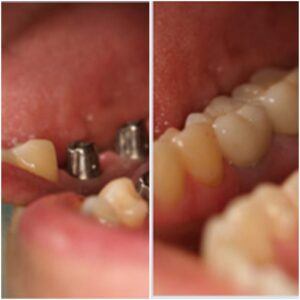Implants before and after restoration

The patient has lost both molars. The first picture shows the Implant abutments. In the second picture, you can see the crowns placed on the implants. Dr. Kohler provides dental implants for the ultimate natural-looking and feeling tooth replacement. Chicago-area residents considering traditional bridges or dentures should consider this modern alternative, whether to replace a single tooth or a complete set. Dental implants can significantly improve the quality of life and the health of a person who needs them. However, complications may sometimes occur. Complications can occur soon after dental implant placement or much later. Some complications result in implant failure (usually called implant looseness or loss). Implant failure can result in the need for another surgical procedure to fix or replace the implant system.
The Dental Implant Procedure
The implant procedure begins with placing a metal insert into the jawbone to simulate a natural tooth root. The next step is attaching a metal stud to the insert. This will serve as the anchor for a ceramic replacement tooth. Since embedding the metal in the jaw, dental implants are becoming a substantial part of their dentition and should last many years.
Once healing is complete, Dr. Kohler can provide a permanent restorative solution based on your unique condition. A patient may receive a single dental implant and crown or multiple implants to support partial or complete implant-retained dentures. Single-tooth restorations are individual freestanding units not connected to other teeth or implants used to replace missing individual teeth. An implant-supported bridge(or fixed denture) is a group of teeth secured to dental implants so the user cannot remove the prosthetic. They are similar to conventional bridges, except that the prosthesis is supported and retained by one or more implants instead of natural teeth. A removable implant-supported denture is a removable prosthesis that replaces teeth, using implants to improve support, retention, and stability. They are most commonly complete dentures (as opposed to partial), used to restore edentulous dental arches.